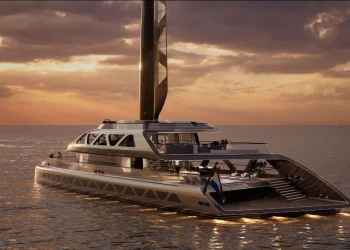
Royal Huisman, rebirth of a legend
Nearly 94 years after her launch, Atlantide has been fully renewed and reawakened by the artisans at Huisfit by Royal Huisman. Following a complete rebuild, the Huisfit team is now excited to place the remarkable 37m / 122ft motorsailer in the spotlight she deserves, sharing insights and a stunning new photo library.
In January 2021, this laurelled, historic Little Ship of Dunkirk arrived as deck cargo from the US and entered the shipyard for repairs and interior modifications. In November 2023, she sailed away from Huisfit after a full rebuild with 40 per cent of her hull, deck and frames replaced, her interior fully reimagined and every onboard system except her original Gardner diesels fully overhauled or replaced.
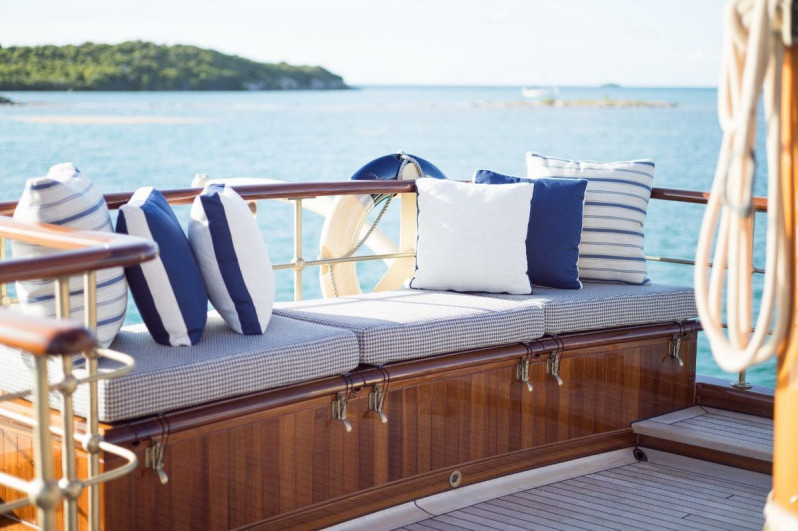
Her current owner, Jim Clark, has built three sailing yachts at Royal Huisman, the sloop Hyperion (1998), schooner Athena (2004) and the J Class Hanuman (2009). When Atlantide came on the market in 2020, he and wife, Kristy, felt that Atlantide would make a charming accompaniment to their J Class racing yacht.
“Hanuman was in the shipyard for some updates in October and Mr Clark asked if we could refit Atlantide the following year,” said a Royal Huisman spokesman. “The next thing we knew, he’d decided to ship Atlantide to the Netherlands immediately instead of waiting.”
Since the refit team hadn’t seen the boat out of the water until it was hauled at the shipyard, the actual scope of the project still needed to be determined.
It wasn’t long before the workmen discovered what appeared to be a crack in the hull. Fearing the worst, they began
poking and picking at the gap. As pieces fell to the floor, they were relieved to see that it was filler material, not steel flaking away — but there was a surprising amount of it, about two inches thick in many places.
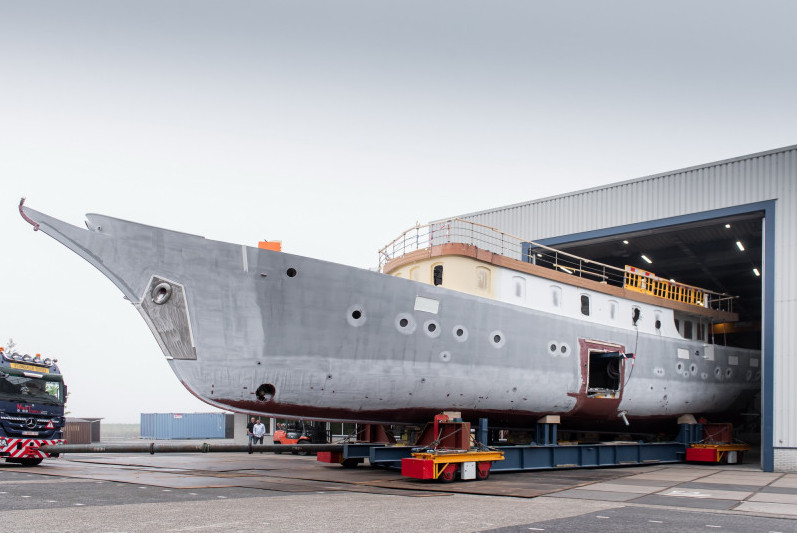
The full extent of the problem was revealed when the hull and deck were blasted to raw metal, exposing dented and deformed structure. An exterior refresh just became more complicated. When workers began to remove the main deck windows in preparation for sanding the superstructure, they discovered that they were not actually mounted in frames but glued into openings packed and shaped with filler.
Meanwhile, the team evaluating the interior discovered ongoing deck leaks had led to wet interior bulkheads, MDF
substrates and built-ins. A straightforward interior refit quickly turned into an order to replace everything.
WHEN A REFIT BECAME A REBUILD
For the next six months the Huisfit team studied, scanned and redesigned the boat in 3D. They noted that they had to use “sailboat thinking” to plan fitting new equipment, systems and lights as there was almost no space behind the walls or above the overheads.
There had been almost no insulation in the hull or superstructure and that needed to be remedied. In-house pipefitters began to customize pieces, even sourcing square PVC to optimize space by nestlng pipes and conduit alongside frames.
The entire teak deckhouse was lifted off in one piece for restoration, preservation, strengthening, and refinishing in a dust-free environment.
Every piece of deck hardware, including port hole covers, was removed and catalogued for restoration. The work list grew.
With the interior stripped to metal, new insulation, including anti-drumming panels, could cover every inch before framing the new interior began.While the Clarks wished Atlantide’s postwar profile to remain untouched, they wanted to simplify the style of the interior, replacing the elaborate Art Deco features installed by previous owner Tom Perkins.
Clark had formed a bond with the late designer Pieter Beeldsnijder over the course of three yachts and now he turned to the firm deVosdeVries design, whose principals had been part of Beeldsnijder’s team, for the refit. The Clarks briefed a less ornate 1930’s style married with the look of Hanuman’s classic interior that was created by Royal Huisman’s artisans in French walnut.
This is complemented by an artful antiqued finish created by an intensive 200-year-old process. To achieve this look, art and architectural renovation experts Acanthus International of Palm Beach, Florida, applied a 14-step finish of bleaching, coloring, French polishing, and distressing, all by hand.
While the paneling and cabinetry could be built offsite, the flawless finish could only be accomplished once it was fitted aboard. The result not only rivals collector-quality period furniture, but is perfectly in keeping with the yacht’s ethos.
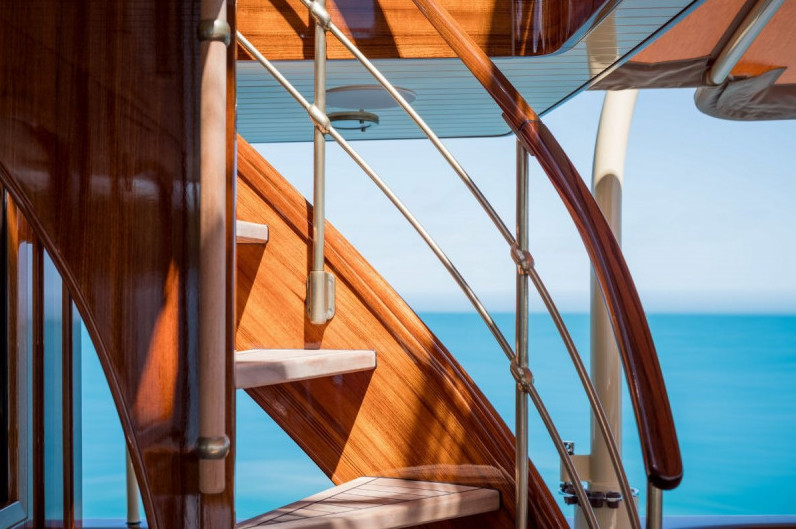
UPDATING THE GA
While the owner’s stateroom and VIP aft keep to their previous footprint, the spaces are barely recognizable and recall quiet luxury.
To squeeze every bit of space possible for the accommodations, the pipefitters and carpenters measured voids to the fraction of an inch. In fact, to create a bit more ceiling height for the owners, the propulsion shaft locks reside just ¼-inch below the owner’s stateroom floor.
The designers sought to minimize the impact of the hull curve in the owner’s stateroom lowering the bed and rethinking storage.
Handsome detached night stands were added and port holes relocated. Here as in several other interior spaces, built-in bookcases were added. Just forward of the owner’s suite is a beautiful stateroom for guests in identical style and finishes.
Below forward is a refreshed flex cabin for either Atlantide’s captain or extra guests.
The galley also keeps its familiar footprint, but features modern white cabinets and professional surfaces surrounding new appliances.
So, too, the entire three story main staircase has been reconfigured in a style in keeping with the 1930s. Gone are steps radiating from a polished stainless steel column and gleaming railings reflected in high-gloss bird’s- eyemaple panels.
Now, a more comfortable staircase with a genre-appropriate, raised-panel walnut staircase surround and a wood-clad center post is the center of circulation. The previous highgloss teak and holly sole has been replaced with wide-planked natural finish walnut.
The main saloon is now a more casual space focusing on plump French-blue sofas for après regatta relaxation. This is very much a boat for personal living rather than high-profile entertaining. A shallow coffered ceiling style is a softer look than the lacquered tongue-and-groove panels from the Perkin’s high-profile refit during the late nineties. Now, French-polish straight grain walnut joinery paired with walnut burl panel insets and hand-painted overheads look perfectly at home.
One of the biggest changes is that the former indoor dining saloon overlooking the foredeck is now a comfortable media room with a welcoming overstuffed sofa and chairs upholstered in a linentextured off-white shade.
Dining has moved to the aft deck under a fixed bimini awning with removable weather curtains. An enormous custom table on centreline showcases the joiner’s skill with a diamond design and glass-like surface finish. Comfortable, padded captain’s chairs are easy to position at will or store on passages.
A small, matching teak cabinet nestled between the curved steps to the upper deck and the door to the saloon facilitates meal service. The fantail is filled with large cushions and pillows for lounging.
The wheelhouse is the only area of the yacht with a teak interior matching the varnished teak brightwork outside. It’s a nice homage to tradition. Ninety-five percent of the exterior bronze fittings are original and beautifully restored. With every original overhead removed, redoing the lighting plan was an easy decision and deVosdeVries design brought in the same type of ambient lighting the owners enjoy on Hanuman.
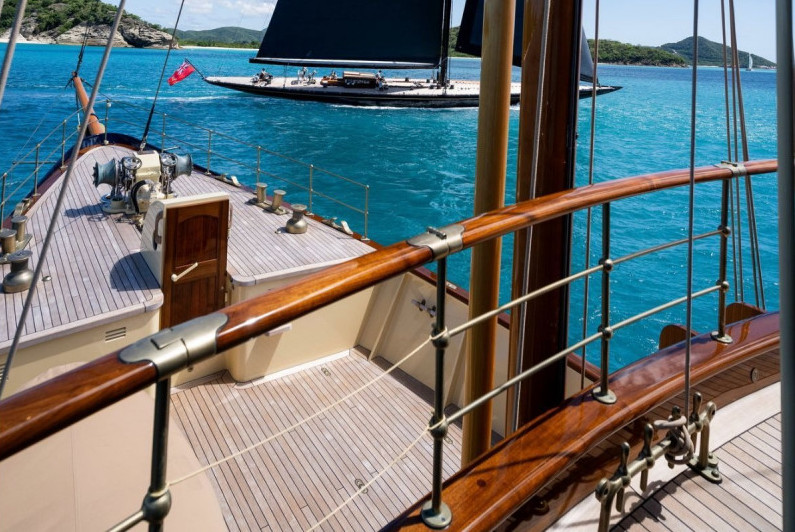
UNDOING WELL-INTENTIONED MODIFICATIONS
Caleta, as she was called at launch in 1930, was originally painted white with a varnished teak superstructure and a black smokestack. When she was taken by the British Navy for use in WWII, her yachty features disappeared. High maintenance items such as teak bright work were given a dull coat of brown paint, thought to protect the wood until such time as it would be returned to yacht service.
The tiny teak pilot house may have received some plating as the ship was lightly armed for fight. Along the way, her subsequent yacht restorations first expanded the main deckhouse and then rebuilt it in aluminum, topping it with a teak bridge deckhouse. But aluminum and steel don’t play well together and even though some effort had been made to isolate the two materials, when the yacht was dismantled for this project, galvanic corrosion was evident and much more than the joint needed replacement.
Along with new deck and superstructure plating, Huisfit also re-engineered the skylights. “There is only one way to do things for an experienced returning owner like Jim Clark,” said says Huisfit’s spokesman. “When we would discover problems, we know what he expects”.
Hanuman’s captain, Josh Luckhurst, served as project manager and supplied on-the-spot decisions. “The previous owners did not keep a full-time crew on the boat as they tended to use it only in summer and it suffered a bit for that,” Clark said. “And it appears that some early work may have been more about cosmetics or meeting a deadline than longevity of the vessel. Everything that Royal Huisman replaced was done with the highest quality.”
The ship appears to have always been a bit asymmetrical – a previous captain noted that it didn’t sail quite straight– however, 93 years and war action had taken their toll. In some places, the steel hull plates sagged against the frames. Rather than replace misshapen steel plate that was otherwise sound, shipwrights carefully heated and stretched the metal, helping it flatten as it cooled, so that less filler would be needed for a smooth finish. Of course, the fancy trail boards no longer fit so they scanned the originals as well as the hull and milled glamorous new, gold-looking 3D elements. The largest challenge, one of the foremen said, was taking things apart and redesigning at the same time. “That’s what took time,” he said. “We rarely get involved in designing because it is usually already designed before a yacht comes in for a refit.”
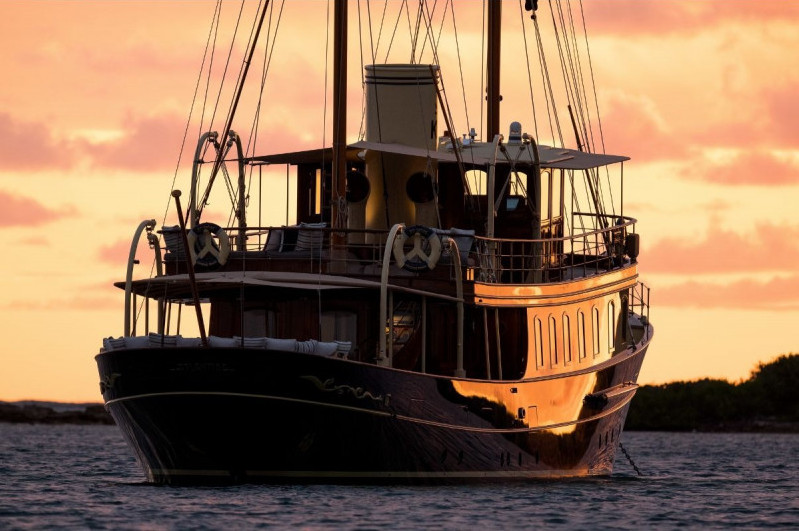
To help with maneuvering, Huisfit’s engineers proposed a modification to the original rudder. They increased its size by about 20 per cent and extended it to fill a small gap below the keel area to help the vessel track better. Equally important, it reduced turbulence. Additionally, the stabilizers were upgraded with new fins presenting 18 per cent larger surface area and Naiad AtRest controllers featuring faster response, especially at slow or no speed. Captain Luckhurst noted that on the passage from Palm Beach to the Caribbean in February 2024, Atlantide was “incredibly stable”.
ATLANTIDE’S HEART REMAINS IN PERFECT ORDER
Crating up a pair of 3635kg / 8014lbs engines is no easy task, especially as soft patch openings were never envisioned for Atlantide’s decks. To minimize damage, a single 2.5m / 8ft opening was cut in the portside hull and a temporary boom crane welded to the engine room overheads allowed the 8-cylinder, 255hp Gardner engines to be slid out of the hull and shipped home for a thorough reconditioning.
“They are very straightforward machines that work well. We just added some sensors and alarms,” said a Huisfit spokesman. The Gardner twins left their home in Canterbury, UK, in February 2022 complete with new Twin Disc reversing gearboxes ready, the company asserts, for another 50 years of service. Huisfit matched them up with a new split exhaust system, that discharges either through the yachts funnel or at waterline. A beautiful new genset installation and electrical switchboard was custom made to fit Atlantide’s compact engine room. In fact everything from watermakers to stabilizer fins was uniquely tailored to fit the project, the latter designed to fit the hull shape via 3D modeling. One of the managers called it “an interesting puzzle”, although one suspects that is an understatement.
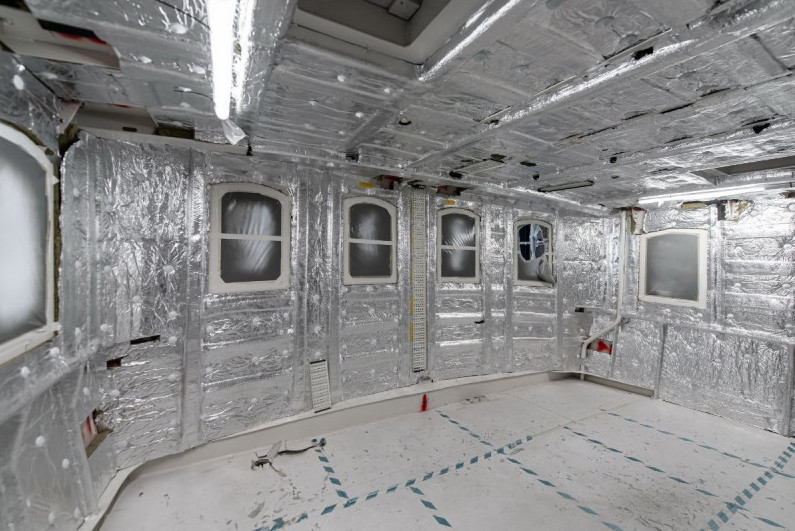
As much of the original exterior teak as possible, including massive cap rails, was saved, restored, and pieced back in with new wood. So, too, were the winches, which are thought to be 60- to 70- years old. All salvageable hardware was overhauled and polished, and both old and new pieces were given an aluminum-bronze chemical treatment for a smooth, satin, slightly patinaed, finish.
Although the bridge looks classic and keeps to its original footprint, the yacht has been treated to brand new systems
monitoring, navigation and communications gear and exterior LED lighting.
When originally launched nearly one century ago, folks were still a bit skeptical of relying solely on diesel engines. Just as with every yacht her age, Caleta was rigged to sail if necessary to extend range or get home. It’s probably not surprising that the Clark’s work list included a brand new rig and sails, all built to the original plan that pushed her along at up to seven knots. The Clarks will primarily use Atlantide as a day boat during the summer where she will be moored at Martha’s Vineyard and as a tender to Hanuman at bucket races.

READY FOR HER NEXT CENTURY
Ninety-three years on and this little gentleman’s yacht tender is ready to return to her original duty as Lady in Waiting to a magnificent racing yacht, kicking up her heels at all the great regatta venues. Who would have thought she would still be in style? It’s interesting, but perhaps not surprising, how the rebirth of the J Class itself has given rise for a reverence to these classic “tenders”. There is a sense of romance — perhaps even a longing for — the golden age of yachting, or at least how we imagine it to be.
“It’s a work of art,” states Clark. “There were parts of the yacht, [both the interior and the mechanical spaces] that were not well thought out before. Now it is.”
Of course it’s technology, from air conditioning and insulation to stabilizers, and powered winches to fiber optic cables that make the dream work for today’s discerning owners. No doubt Celata’s owner would recognize his proud little ship and be thoroughly amazed.
“What I like is the historic quality of this boat; nothing is plastic,” says Clark. Thinking of the J and back to Athena, perhaps it is no surprise when he adds, ”I’m a classic boat snob. I like the old wood look; big modern boats do nothing for me.”
“What I like is the historic quality of this boat; nothing is plastic. I’m a classic boat snob. I like the old wood look; big modern boats do nothing for me” Jim Clark




